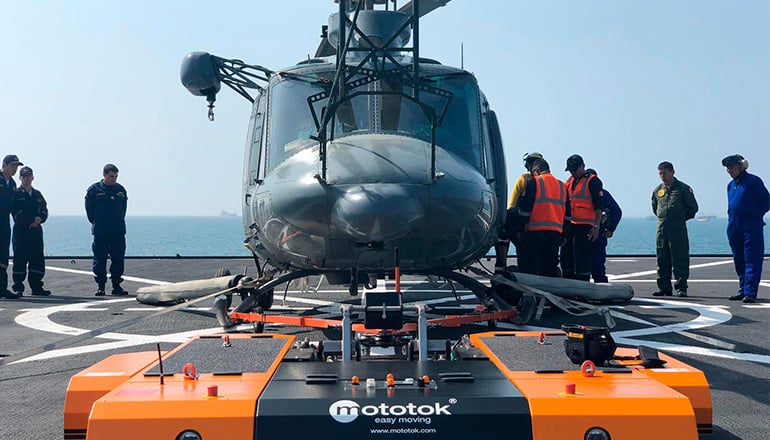Helicopters are perhaps the tremendous revolutionary technology in aviation since powered flight, and certainly have proven to be one of the most important evolutionary processes of powered flight.
Helicopters have proven to be one of the most versatile, practical, and clutch aerial platforms the world has ever known. However, they are problematic aircraft to maneuver on the ground, at least in helicopters with skids for all of their usefulness. Mototok’s solution to this ground handling problem is our Helimo aircraft tug, a genuinely universal tug for your entire fleet of skid-wearing helicopters. You may be moving a Bell 212 and need to move a Eurocopter EC145 immediately after; there is no need to change up your GSE because Helimo can handle it all.
Helicopter History
Interestingly enough, the inquisition into powered vertical flight happened almost in concert with powered fixed-wing flight. The first powered helicopter was built 1907 by French inventor Paul Cornu, who made his way about a foot off the ground for a sustained flight of just about 20 seconds. While this seems paltry now, it was earth-shaking at the time.
Over the next quarter of a century, advances in rotary-wing technology were decentralized on two different fronts: autogyros and helicopters, with autogyros seeing the lion’s share of advances during the period.
Autogyros possess certain advantages, although those slight advantages turned into utter obsolescence as time marched on. Autogyros have been relegated to hobbyist use exclusively because they offer very little over what can be found in a comparable fixed-wing, but with more complexity and a worse safety record.
The big hindrance to helicopter development was engine performance versus weight. Piston engines were the only option for many years, and their thrust-to-weight ratio was sub-optimum for vertical flight. Weight is always the primary determining factor in all flights, but especially so in vertical flights.
The first highly successful helicopter that was mass produced was the Bell 47, a twin-seat, piston-powered helicopter that operated on a skid landing gear. Sikorsky’s designs were successful, with some being implemented for search and rescue tasks as early as 1942 (S-47/R-4). Still, it was the iconic Bell 47, especially with its extensive use throughout the Korean War and media exposure on the tv series “MASH.”
The heyday of the modern helicopter began after the Korean War, in the 1950s, as turbine engine technology began a repid incline in reliability and availability. To be perfectly truthful, without the advances in turbine engine technology, rotorcraft, as we know them now, would never be. This is not to say that there were no large helicopters with piston engines; several successful helicopters initially began as piston-powered helicopters, namely the Sikorsky S-58, which carried the name of H-34 “Choctaw'' in military use. This medium-size helicopter was initially outfitted with the robust but very heavy Wright R-1820-84 Cyclone (dry weight of nearly 1,200lbs), but the many examples still in service around the globe have been converted to the Pratt & Whitney PT6T, a turbine with a dry weight of half (617lbs.) that of the Cyclone.
About Helicopter Skids
But back to skids. Why do so many light and medium helicopters have skids over wheels? Skids are a simple landing gear system where the shock absorption is built directly into the skid. The cross braces are curved, attaching to the skids via the use of a saddle. These curved skids are very light, with modern helicopters using advanced composite materials that are highly flexible while being very light.
Skids are also much lower in terms of maintenance. The components are simple and relatively inexpensive to replace. They are also very, very light. Landing gear systems are far heavier, being composed of large, structural components (pistons, tires, brakes), and are usually reserved for medium and large helicopters, which tend to have ample horsepower.
Of course, the tradeoff for light weight is strength. There is a point in time in which the design of skid systems can no longer adequately support the weight of a large helicopter. Also, larger helicopters often rely on a translational lift to ease takeoffs with heavy loads.
The Most Popular Helicopters with Skids, and What they DoIt is no irony that the most popular helicopters in the world are equipped with skids. The highest demand in the world is for small- and medium-duty helicopters that seat anywhere between two (Robinson R-22) and 12-14 people (Bell 212 and 412), depending on the needs of the operator.
Bell 206
The Bell 206 is probably the most important light helicopter of all time, really. First introduced in 1962 and produced all the way until 2017, around 7,300 units of various Bell 206 models were produced. The Bell 206 has found uses in almost anything you can imagine: aerial agricultural application, air ambulance, extensively in police use, executive transport, aerial news reporting, and everything else.
With a dry weight of 2,331lbs, and an operation weight of considerably more than that, moving the Bell 206 is too much by hand, although skid wheel dollys are not uncommon, they are not practical. Another method of transporting the 206 is a skid trailer, a sort of dolly trailer that can be towed around by a small tractor. The problem with these is that you have to land on them, which is not a very big target.
The Helimo eliminates this problem entirely. No obnoxious dolly wheels on your skids, no trailer to land on. The Helimo is easy to manuever into position and lift the aircraft gently off of the ground. In fact, the Helimo operator can even sit in the pilot seat and ride in the helicopter if they need to for a longer tow, which is particularly helpful if they need access to the radios for crossing runways.
Eurocopter AS350/Airbus H125
A prime competitor of the Bell 206 and long-running mainstay of the light helicopter world, the AS350 is another highly reliable and proven design that has stood the test of time and continues to soldier on. With a first flight in 1974 and production beginning in 1975, it has consistently proven it’s worth, serving in military and police units far too numerous to mention.
With an empty weight of 2,588lbs, and a maximum gross weight of 4,960lbs, the AS350 is not a lightweight on the ground. But that is no matter; the Helimo has a capacity of six tons, so the AS350 is no concern at all. Plus, the Helimo is compatible with a wide array of common add-ons, including FLIR-pods, lights, cameras, and more.
Bell 212/412
The previous makes and models were not pushing the envelope of the Helimo’s capacity, so let’s explore a popular line of helicopters that are on the heavy side. You can conceive that an empty Bell 206 could probably be moved around by hand on the dollys, albeit with a fair amount of effort, but what about a Bell 412, with an empty weight of 6,789lbs, and a MGTOW of 11,900lbs? It doesn’t matter what your deadlift is, you are not moving that aircraft on your own.
The Bell 212 can carry up to 14 passengers, yet only requires a crew of one for VFR flight, which certainly puts the pilot at a disadvantage when he needs to get the helicopter out of the hangar.
The Mototok Advantage
We operate under the premise that you might not have a full team at your disposal to help conduct towing operations. There is probably no application where this is more accurate than VFR helicopter operations, where a single pilot routinely handles the operation. He or she is certainly not able to just call in a team to help out on a whim, which is where the Mototok advantage is the clearest.
Our entire lineup of tugs are designed with the sole operator in mind. We know that he may very well find himself or herself pulling a helicopter out of a crowded hangar and putting it back in. Mototok designs our equipment to make the action of aircraft movement very simple, and very safe, two things it has not historically always been. It is generally considered an unsafe maneuver for the tug operator to move aircraft in tight spaces without wing walkers because his perspective from the driver seat is distorted; he cannot accurately gauge the distance from a wing tip or rotor tip from an object.
All of our units are fully remotely operated, so the operator can walk to and position themselves in full view of all wingtips, rotors, and the tail for height issues. The Helimo adjusts in width to work with just about any helicopter on skids, as long as it is under six tons. It is supremely adaptable, being able to access the outside of the skids, or narrowly operate in between the skids.
Conclusion
Helicopters are a crucial part of the aviation ecosystem, providing services that nothing else in the world can provide. They shuttle crews between off-shore oil rigs, put out fires, rescue hikers from mountains, and even carry giant chainsaws to clear tree limbs from power lines. What they are not good at is being moved around on the ground when they are equipped with skids for a landing gear. Mototok’s Helimo is your solution to this problem, freeing up time and your most precious resource: people. Call us today to schedule your demo!



Comments